Niki Raapana is guest posting for us today about the Gertee a house made from scraps:
You’re looking at a disaster that used to be a livable house. Besides the wood, doors and windows, you also see curtains, beddings and other fabrics poking out. Where many people see only a trash pile, I see enormous potential. Why? Because even if the wood is singed and the fabrics have rips, I know that with just a few simple tools, a way to cut the wood and wash the materials, we have the makings for a little temporary house I call gertee.
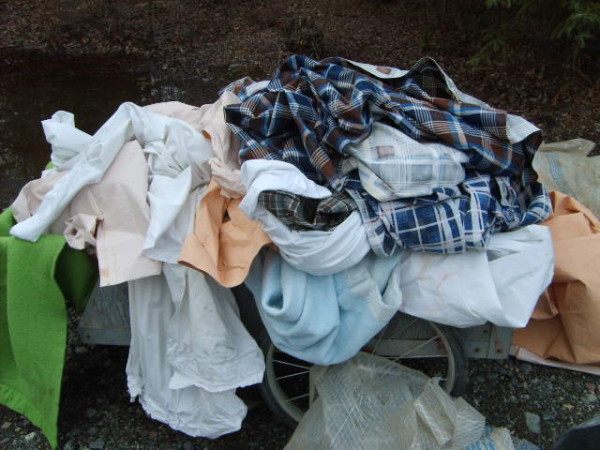
Gertees are basically standard yurts made from raw or salvaged materials. Unlike the Mongolian and Western versions (exquisitely crafted and covered in gorgeous fabrics), gertee is the budget variety. It utilizes many items that would otherwise go to the dump.

A 16 foot wide gertee needs about 80 wall slats. If there are at least 20 2x4s in your mix (or fifteen 2x6s or eight 2x12s), these can be cut down into 1/4 inch slats. Even broken boards will work as your walls can be made as short as 5 feet. Pipe or other metals can also be used although not as easily as the wood. Short thin trees and bamboo work too.
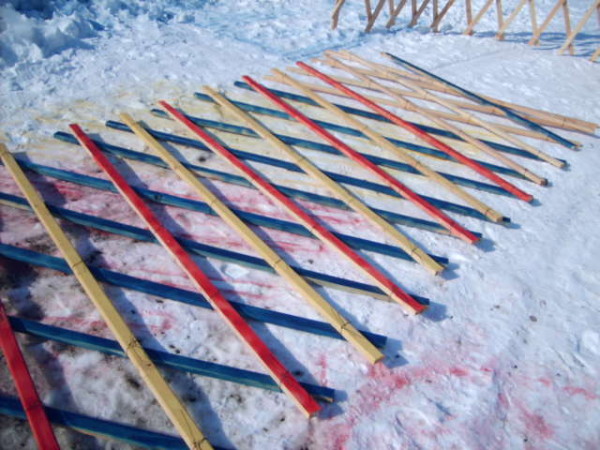
The walls slats are laid out like lattice on the ground and tied together at each cross. It takes 320 ties if you have four crosses on each board. The ties can be cut from scraps of string or fabrics. If at all possible, I recommend buying 400 8 inch plastic zip ties. Once tied together the walls slide together like an accordian and roll up for easy carrying.
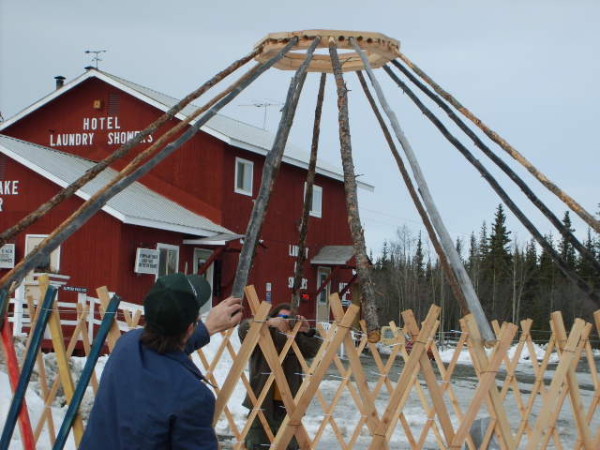
A 16 foot gertee can be made with as few as 8 roof poles, more is better but not absolutely necessary. Poles need to be at least 9 feet long and can be as slim as a 2×2.
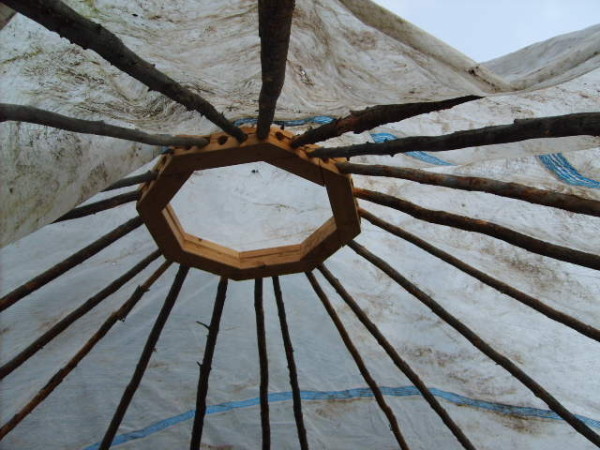
The roof ring is by far the hardest piece to make. It may take more imagination than the rest of the parts, unless there is a carpenter handy who can fashion one out of leftover wood pieces and has a drill to make the holes. I’ve made one roof ring (my first) from a piece of metal screen that I curved into a circle, and I think teepee roof poles tied together might also work, although I haven’t tried it yet. I also think a square roof ring may be okay. The roof rings we make for the gertees we live in now are 2′ wide octagon shape.

The door frame can be made of 4 boards screwed together to form a rectangle or a standard door with a frame can be used, even if the walls are shorter than the door.

The roof cover can be made from anything waterproof. I have used a combination of tent bottoms scraps, airplane covers and one time I used a slghtly ripped up sheet of construction plastic. Some sort of weatherproof glue is necessary if you don’t have one piece large enough to cover the entire roof. Square tarps work perfectly.

Today I cover all my gertees in recycled 24×24′ billboards, which are already fire, mold and UV treated.

The exterior walls can be covered in pieces of fabric or plastic/tarps/canvas. The interior walls can be covered in screens, sheets, blankets and bolts of fabric.
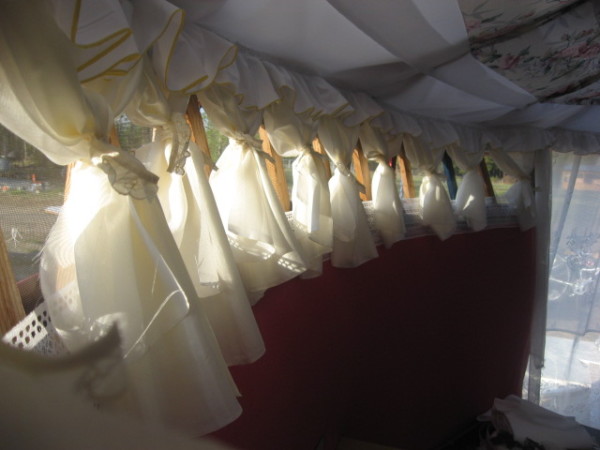
We’ve been living in our homemade gertees in interior Alaska for three years. While we’ve definitely improved on the materials we use to cover our roof and walls, we still keep a sharp lookout for useful throwaway items. The first 16′ frame endured six moves and rebuilds. Our initial concern that the zip ties would slip too much was unfounded.

As for staying warm in a gertee… well, I’m in one right now (written on 1/24/10). It’s a brisk 40 below zero outside and I’m sitting at my desk in a thin sleeveless dress, wool socks and my slippers.
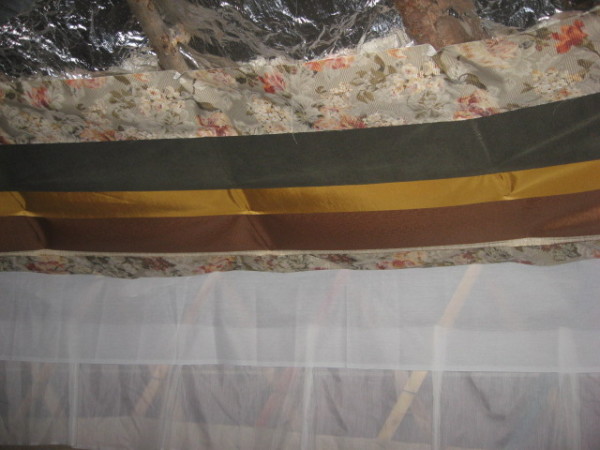
I have RadiantGUARD foil insulation on all the walls and the ceilings plus an extra layer of R19 in the new addition. I have one long strip of canvas on the outside walls and this year I used the same canvas on the inside walls. I still use old blankets and scrap materials too.

We have two gertees attached together this winter. The main gertee is now the kitchen with a wood stove in the center. The new room is the bedroom and bath and it has its own woodstove with the stack going out through the wall. With both fires going steady neither one has to burn too hot to keep it at around 68 degrees. Of course smaller fires means more work feeding them constantly, and a thermostat heater is on our wish list, for sure.

I just took a nice hot shower. My gertees have no plumbing so my winter shower is a 2 gal solar bag filled with hot water from big metal pots kept on our woodstove 24/7. I stand in a 2′ metal wash bucket with a plastic shower curtain tucked inside it. Works beautifully.

While the gertee lifestyle is certainly not for everyone, we believe it has changed our lives for the better. The ability to eliminate many of the costs that come along with renting someone’s four square walls has been a boost to our spirits and our creativity.

There is something very nurturing about living in a round room, once you get the hang of how to arrange the furniture. We now think in circles and “pies” and not squares and rectangles.

We’re set up in a year round campground, have electric and phone (usually) and the rest we do for ourselves. It’s been amazing to see what kinds of things we need and how hard it is to find some of them. Sometimes it hits us how we could be making things we’ve always bought, like rope, and now we make our own. Gertee has caused me to try things I never imagined I wanted to learn, like my chainsaw, which I started using to cut firewood but now have made 2 doors and all kinds of structural changes with it.
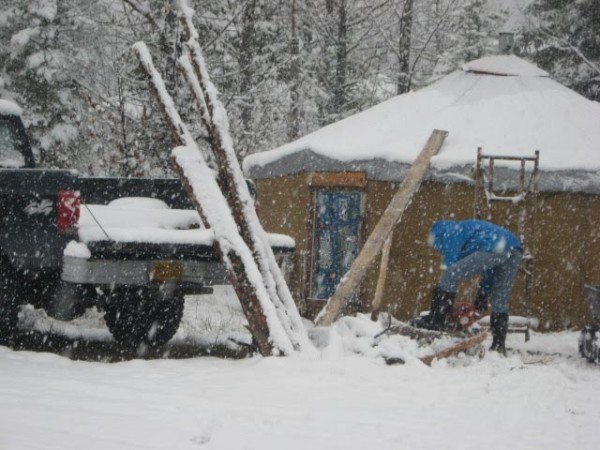
I have to say the best part of my gertee experience is the satisfaction of knowing I live in my own house I built with my own two hands. I own it free and clear and can change it anytime I choose (which is often because I’m an American middle aged woman).

The best part for everyone else like me who needs a home is, Gertee is an affordable, livable option that can be modified to adapt to any climate. Green by natural design, yurts have a low carbon footprint and are a proven sustainable house; the Mongolians have been living in them for more than 3000 years without it destroying their environment.

Our Gertee book is under development and will be available in April 2010.

…why is it that when I see the inside of a Yurt it is always cluttered?
To paraphrase a great Einstein quote…
If a cluttered home is a sign of a cluttered mind, what then is an empty home a sign of?
Of course all of these depend on the home and the quality of the existing finishes, etc. I have often seen people replace beautiful 1950s or 1960s doors, trim and hardware for cheap junk from Home Depot. Please don’t do that! Learn to embrace the vintage stuff in the home if possible.
Wow, I’m impressed! Amazing that it is all made from stuff that most of us would throw away. Congrats on building a useable space, especially in a tough environment. And thanks for the great ideas. While I might never live in a yurt, I’m thinking it would make a great space to get away for some privacy. My husband and I live in 700 sq ft cabin. Occasionally, I’d like to just escape. Or it could be my art studio, which I had to dismantle when we moved.
I just love the idea of a yurt.
It gives me a feeling of just hiding away from the world for sometime in the little personal yurt.
Great article.
As a long time Alaskan (23 years) I can appreciate your toughness and ingenuity in the face of the climate.
I also appreciate your sharing the details of the construction… Seems I remember seeing one where the person used an old bike tire rim for the “roof ring.”
I’m in Oregon now, but I sure do miss The Last Frontier at times.
Best wishes.
Long time reader, first time commenter. This is awesome – exactly what we’re trying to do with our lives. We’re working on our masterplan to run a micro-online business, own a semi-permanent movable tiny home, and live as sustainably as possible. This is very inspiring.
I’m another long time reader, first time commenter. There is something about yurts that has always appealed to me. Now the Gertee makes it seem totally do-able for me to build one. I’ll be looking for their book.
Thanks to Kent for sharing this here.
I totally agree with Matt and see a real need for a line of DIY portable cupboards and shelving. 🙂
Marys, Mark and Michelle, I appreciate all your comments and as I am working on the how-to book now, I’m wondering if there is any specific information you’d like to see us include.
I want to keep it very, very simple in the instruction portion, but thought it might be useful to add another section about the gertee lifestyle, describe how we manage it daily, as in tools, chores, wood stove cooking, etc.
I lived in AK from the 70s to the 90s, then we moved to Las Vegas, Madison, and ended up staying for 5 years in Seattle. We loved that city and it was a exceptionally rewarding time of our lives. There is something very special about walking down the street and seeing all the people and little shops. Besides the abundance of unique company and entertainment, we learned a lot about privacy and safe and affordable housing.
It was never my plan to return to Alaska and build little dry huts a 5 hour drive from any city. It’s one of those things where people can say to me, “Be careful what you wish for.”
Niki,
Thank you for offering this information. It means a lot to people who are motivated by self-sufficiency.
I hope you follow through with your plans to produce a book detailing how simple Gertees could be designed and built using recycled or reclaimed materials.
Best of luck!
Hi Epperson,
Thank you so very much for supporting my endeavor, it means a lot to know not everyone thinks I’m barely one step up from a bag lady. 🙂
I got the label “tent woman” from a US history teacher who admired my work and efforts the first time I went winter camping in Washington state in 2002. When I moved into Tim’s campground in 2006 and everybody was asking him who I was, I told him to tell them I was the “tent woman”. Being an old fashioned guy he changed it to Tent Lady. You wouldn’t believe how many people wrote me and told me to quit living in a tent because it made me look like a nutcase. So many complained that I started calling myself the Tent lady on my blog.
No matter what anyone else ever thought of us, I knew we were doing something right and good and always hoped we’d someday get the respect we’ve earned for trying. Part of the problem with all the new regulations and land planning is the limitations it places on our ability to try new things. In our case what we’re doing is not new at all, but it sure is new to most Americans who have been taught houses have to be made a certain way and have all kinds of extra things.
I’ve already seen the novel ideas other people bring to gertee making, and we’ve dreamed about all kinds of additions and upgrades. If nothing else, it inspires us to dream. I’ve never forgotten the words from South Pacific: “you’ve got to have a dream, if you don’t have a dream, how you gonna have a dream come true?”
I’m definitely going to finish the book and the DVD, I’m already half finished and fully committed to promoting it in book fairs and other places. My latest dream is to travel the US and beyond, building gertees out of local materials. A book tour is under discussion.
Niki,
You have something much more important than most people living in the lower 48, FREEDOM.
If you haven’t noticed, we’re moving closer and closer towards Serfdom. And the answer is no, we don’t have “Freedom” the way the Founders intended.
Americans are educated but not “Classically Educated”. They are easily duped by catchy tunes, cheap entertainment, savvy marketing and new age political slogans.
When Americans realize what’s happened to their country and who “really” took over, you’re in a sweet spot on the map and out of harm’s way. I envy you for that.
For the thinking person, alternative forms of Housing should be the way to go moving forward. As you and others have proven, you don’t need to spend an obscene amount of money on plans, materials or trailers to achieve this goal.
Thank you Niki and keep us posted on your Book and DVD.
Hi Epperson,
Thank you so very much for supporting our endeavor, it means a lot to know not everyone thinks I’m barely one step up from a bag lady. 🙂
I got the label “tent woman” from a US history teacher who admired my work and efforts the first time I went winter camping in Washington state in 2002. When I moved into Tim’s campground in 2006 and everybody was asking him who I was, I told him to tell them I was the “tent woman”. Being an old fashioned guy he changed it to Tent Lady. You wouldn’t believe how many people wrote me and told me to quit living in a tent because it made me look like a nutcase. So many complained that I started calling myself the Tent lady on my blog.
No matter what anyone else ever thought of us, I knew we were doing something right and good and always hoped we’d someday get the respect we’ve earned for trying. Part of the problem with all the new regulations and land planning is the limitations it places on our ability to try new things. In our case what we’re doing is not new at all, but it sure is new to most Americans who have been taught houses have to be made a certain way and have all kinds of extra things.
I’ve already seen the novel ideas other people bring to gertee making, and we’ve dreamed about all kinds of additions and upgrades. If nothing else, it inspires us to dream. I’ve never forgotten the words from South Pacific: “you’ve got to have a dream, if you don’t have a dream, how you gonna have a dream come true?”
We’re definitely going to finish the book and the DVD, ACL Books is fully committed to promoting it in book fairs and other places. My latest dream is to travel the US and beyond, building gertees out of local materials. A building-book tour is under discussion now.
Again, thank you for your kind words. Even though I tried not to care what anyone thinks, now that it’s good feedback funny how it means a lot to us. You’re in our hearts.
For portable cupboards, etc. Do a search for a Chuck Box. They are a nice way for tent campers to organize and carry their stuff around. There are some beautiful designs that will work as storage space and counter top yet pack up small for traveling.
This is the way life should be!
Here in the lower 48, you’re Taxed, Regulated and Burdened to death.
To life free and independently is quite dangerous. At least to the money-changers and tax collectors.
This is one of the better posts I’ve seen on this blog. The kits from the McYurts out West are nice but very expensive for what it is.
Epperson you need to thank Niki for such a great post! Unfortunately I can’t always post this kind of detailed information as I am given what people share with me and since I don’t personally live with each person I can only portray what what I receive.
Outstanding article. Question: Instead of the ring at the top, couldn’t you tie the poles in a manner similar to the American Indian teepee poles? It would seem a simpler way to achieve the same end.
Gertee used to be GerTee, half-Ger (mongolian for yurt) and Teepee. It seems like putting the poles like that should work just fine, they do it for circle houses in Africa and weave mats, and other kinds of solutions for a roof. But some designs for yurts I have seen say the roofring, or “hub” is a compression ring and has something to do with the tension, compression, architectural strength of the structure. It would be nice to know for sure! The roofring is a barrier to getting one of these for yourself for sure. It’s either buy or have custom made…if you didn’t need it at all, then bingo…
Great article, Mom! I am so happy you put up all the pictures of the scraps… they are so illustrative. 😀
Here’s a tip for the roof ring that I’ve tried myself. I made a ring from a piece of rebar and had it go THROUGH the poles. I used something like 2″x1″ for the poles. That way, they can’t pop out or get anywhere.
I know this wouldn’t be for me as my solution for living in -20 degrees is to move! I would be concerned for Bears or other wild intruders (Neighbours Excepted.) As you are a middle aged woman your courage & self reliance has to be applauded, so many of us have been controlled & regulated into submission & away from being creative & independant. The exact qualities we will need if war or climatic disasters destroys our own homes.
Hi Glen,
As we do live in a bear infested part of America we share your concerns about the bears. We have loaded guns at the ready but still have no idea exactly what kind of damage a bear would do upon trying to get inside. And we have a LOT of food and cook every day in here, so we need to know. There’s a site called yurtinfo that claims bears cannot get through the khana… my guess is that a bear could simply lean on the roof and crash inwards.
So we hope to set one up in a place where Tim saw 19 grizzlies last summer. We’ll make one out of the same materials we use now and fill it up with dead fish or peanut butter. I’ll tape what happens when the bears come, and yes it will be very scary, I hate being close to them. A friend offered us a pile of rebar in his yard and I want to test a rebar gertee alongside the wood.
20 below is cold, but it makes zero seem warm. That’s one of the main reasons Alaska has so few people, and not everyone here adjusts to it. I moved many times swearing i’d never be back because I was sick and tired of the winters. I know that we’re overjoyed when we wake up and it’s 20 above inside and 40 below outside, so we’ve been camping too long I think. 🙂
Thanks for the applause, we really are just two gals trying to make it however we can, and stay warm while we’re making it. 🙂
I love it that you added the word garbage to the title! The truth is a lot of the things I use I do find in the garbage… but it’s good stuff so I don’t care where it comes from. I was horrified to learn there are ordinances being passed that outlaw dumpster diving and taking things out of the dump. That’s insane to me. I don’t get food out of the dump, now that’s always turned my stomach, but man there is a lot of useable furniture and stuff that gets thrown away in our country. I also brake hard for garage sales and second hand stores.
Great blog! You guys rock. Thanks for sharing your yurt story.
Hi Jennie! Kent has a great blog and we were honored to have an article posted here. It’s pretty cool that you like our little podunk version when you make the most gorgeous homes yourselves. We feel very fortunate for your high end company’s support, like it made us really happy when the Alaskan yurt makers at Nomad Shelters commented on Nordica’s Gertee Prototype youtube video. I’m begining to feel like we’re part of some kind of lovely, generous, loosely affiliated group of people who’ve already been supporting each other for decades. It’s nice.
GREAT article – your book should be extremely helpful to many people! AWESOME resiliency displayed in your character – big Kudos to you!
Thanks Sharon! Kudos to you for seeing what we’re made out of… must be a recognition thing. 🙂
The roof rings are integral to load bearing capacity of the Gertee’s roof. I’d be very careful w/ engineering the ring, as it could make or break your structure. There was a medical study written about in the NY Times about human adaptation to cold climates. For anyone who spends a lot of time outside in the winter, you know that you start to get used to colder temps. The study reflected human’s ability to cope w/ extreme cold. I know it sounds painful for anyone living in the lower 48, but it can be done.
Lucas you’re right, the center ring (called Tono I think in Mongolia) is the hub and appears to hold the tension at exactly the right pressure. One of the problems Tim had with it at first was he wanted it all to be tighter. We used a real cable for the tension band on the 20′ and he kept making it so tight all the walls moved in a foot! I think a big part of the strength is in the flexibility because of what it does when strong winds hit.
As for adapting, I guess it’s something grew up with traveling with my dad who was Army. I moved to Vegas in August, after years in Fairbanks, and I died from the heat the first fall. By spring I was comfortably outside doing things in 114 above.
Looks like a great temporary home while the “little cottage in the woods” is being built 🙂
How does living in the round feel compared to living in a box?
I love it, Colleen…when my son Freddie was born, I lived in a tiny cabin in the woods, and when Mom built her gertee, it was so comfortable that I gave birth in her house rather than mine. Then we moved out of the cabin and into the gertee. It was so homey and much easier to heat than my box. They look like a temporary fix, but when they’re upholstered and furnished and pictures hung on the walls it feels like home forever! 🙂 Connecting two or three of them helps a lot for a growing family too, solving the space issue if you have kids, animals, lots of clothes, a home office, etc.
With the 1/4 inch thick wood wall frame I’m wondering how well yurts stand up to high winds?
Hi Benjamin,
The thin slats work well with 6′ (5 1/2′) walls.
We went to a slightly wider slat when we built our first 20′ gertee with 7′ (6 1/2′) walls.
My 16′ got its roof blown off in a winter storm in 2008, it had no ropes since I took them all off and put them on my 20′. But the walls never moved (and were all that was left standing after a winter). I rebuilt it and then it got hit by a huge dust devil, and again, I didn’t have ropes up yet. I had just completely upholstored the entire inside, walls and roof (it’s the picture with the pretty curtains) when out of nowhere bam! Lifted the whole frame, knocked out a couple roof beams and broke both door frames, 2 broke but the main wall slats were all fine. We used the same frame to build the one we’re in now. and so far… so good. But I do want more ropes up.
Gertee makers can never have too many ropes! The key is in tying down the roof cover and securing it to the ground or the platform. When you use a thin fabric for the roof cover you definitely need to put up more ropes across the top. I’ve been looking at more pictures of Mongolian yurts studying the different ways they tie down their roofs, especially when they use several small pieces. I’ve also been practicing making my own.
We’re sitting in a wind tunnel and I got some good video of them in a couple big wind storms. We live on a plateau between four of the 16 highest mtns in North America and the Chugach Range, we get some very severe storms. The one last fall tore things off Tim’s house and we heard other people besides Nordica say it moved their trucks across the road. It moved gertee’s walls in about 6 inches, but nothing broke and our confidence in the design is very high. The little one we attached to the back last fall barely showed any signs of being in the wind.. its flat roof and R-19 insulation between 6″ wide posts every 4 feet makes it beyond secure.
It’s real scary the first couple storms because wind is SO very loud, you can hear it coming like a monster outside the roof. It hits you right in the pit of your stomach when the whole roof fills up like a balloon and it looks like you’re gonna take off flying. (I started calling Osa dog Toto) I’ve learned a lot about wind now from a local flight instructor who taught me to baffle the roof, we threw tires up one time, and now that’s why you see the orange plastic rings on mine.
He suggested I design a wind break like they use on the big ships so they can stand on the deck in relative calm and quiet. And he disagrees that the wind “moves around” the yurts, says the widest point across gets the full face of it.
I’m embarassed that I dont know more but I’m guessing this is why we see so many long short walls in the countryside of Europe and around each cottage, I think they were windbreaks. If you can break the wind before it hits gertee you could cover the roof with lots of innovative things. It’s nice not to feel like you’re on the way to Oz when 100 mile an hour winds kick up.
I believe that as time passes, the bossy people who are regulating things in the lower 48 will lose control and yurts will be accepted. And gertees too! I believe that NEED will outweigh the regulations.
I hope to build a temp place this summer. We have permission to live in beautiful woods and it would be fun to get out of our mobile home and “camp out”. It will be good practice for the future when we have our own land.
God bless,
joyce
I sure hope you’re right Joyce! What a world it would be if everyone lived in whatever suited their lifestyle AND budget. I loved it when I read it’s tradition in Mongolia to give their daughters a yurt when they grow up. I’m grateful to know my daughter will never be without a home in her lifetime. I don’t follow any of their gert traditions except that one and their definition for gertee, which means “at home” in Mongolian.
If you decide to build a gertee let us know, we’d be happy to answer any questions you have. The cool thing is they can also be built out of nice brand new materials and fabrics that aren’t that expensive but are clean and unstained.
God bless you too, and everyone else here also. I do feel blessed today. To all our relations.
Hi, I love your blog. Is there some way, does anyone know someone to get this info, with pictures, to the people of Haiti? They could really use it. They need ideas along with money and this is a really good idea.
Raven
Hi guys, if you’re encountering problems with the page loading, it might not just be your browser. Make sure you clear your cookies and try to reload the webpage. That might make it work better.
Thank you so much for sharing your depth of experience. It has inspired me to build one as well. I’ve been wanting a yurt or dome, but don’t have the money. I do have some space in the woods behind my apartment where I could begin to explore a shelter in this way. Thank you! And please let us know when the book comes out. I could use all the details that a novice builder would need to know. Even a list of the tools I would need would be extremely helpful, as I have none beyond a hammer and screwdriver.
I think I could start on the lattice immediately if I can figure out the dimensions and how to find lumber that is small enough to fit in the tiny car I have. I also have a ton of ironwood in the woods and am wondering if that is good for the ceiling (it grows like weeds here).
Is your book out yet? “Cause I would sure like to get a copy.
Thanks!
Leigh
I have started building a yurt made to be put on a single wheeled cart to take with me in the high mountains of Oregon. This yurt has 3′ tall walls and a super pitch to the roof so that you cab stand up once inside. I am using a bicycle rim without the spokes for a center ring. I used 1X2’s for the lattice and when puttung up there are wing nuts that remove to put verticle stablisers on which have two functions 1 to insure correct height all around the wall and 2 extra weight support for snow load. The rafts are 8 foot long 3/4 inch dowels. The covers I am using wool blankets covered by camo tarps. When winter camping I will be taking my $100 light weight military mini barrel wood stove.